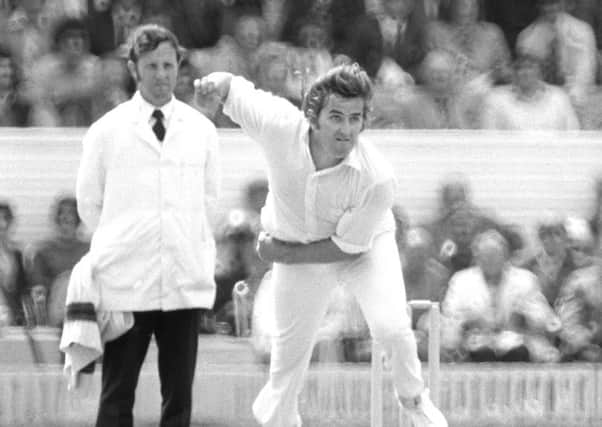‘I was on a high, felt I was infallible and was going to be Australia’s hero’


The game took place at Headingley and Australia won a stirring semi-final by four wickets.
Advertisement
Hide AdAdvertisement
Hide AdThe star of the show was Gary Gilmour, a 23-year-old left-arm pace bowler who took 6-14 from 12 overs before striking an unbeaten 28 in a low-scoring contest.
It remains one of the great individual performances in one-day cricket.
Gilmour, stockily-built with shoulder-length hair and sideburns, destroyed England with late swing in heavy conditions. YouTube preserves his hour of triumph.
The carnage begins when Dennis Amiss walks across a good length ball and is trapped in front by a devilish inswinger. 2-1.
Advertisement
Hide AdAdvertisement
Hide AdBarry Wood is emphatically bowled by a near-yorker – Gilmour’s gut threatening to bust out of his trousers as he tucks them in during muted celebrations. 11-2.
Tony Greig flashes hard at an outswinger and is brilliantly caught one-handed by wicketkeeper Rod Marsh, diving to his right, practically stealing the ball from under the nose of slip fielder Ian Chappell. 26-3.
Frank Hayes – moments after mowing a full toss from Gilmour through mid-on for four towards the old pavilion – pads up to a good-length ball and walks off to audible chuntering from the Yorkshire crowd. 33-4.
Keith Fletcher goes back to a delivery that ducks back in to him and traps him lbw. 35-5.
Advertisement
Hide AdAdvertisement
Hide AdAs Gilmour runs riot, a purring Peter West captures the mood for BBC viewers. “This is a magnificent spell of bowling by Gilmour,” he says. “Alan Davidson would have been proud to put in a spell like this.”
Then, as the camera trains in on Gilmour’s pugilistic complexion, curved into the trace of a smile, West adds: “The picture of a bowler with his tail up.”
No sooner have the words left his lips than Alan Knott goes back to a ball that pins him in front. 35-6.
At this stage, Gilmour’s figures are 6-10.
After Yorkshire’s Chris Old falls to pace bowler Max Walker, leaving England 37-7, the home team rally to 93 all out on the back of 27 from captain Mike Denness and 18 not out from No 10 Geoff Arnold. Later, Gilmour would recall: “I wanted to bowl and bowl. I didn’t want my overs to run out.”
Advertisement
Hide AdAdvertisement
Hide AdRemarkably, on a pitch widely criticised as unsuitable for the big occasion, England’s paltry score threatened to prove sufficient. Australia plunged to 39-6 in reply, Old leading the way with three wickets. But “Gus” Gilmour was not done.
With his team’s hopes of reaching the inaugural World Cup final hanging by a thread, he strode out at No 8 and promptly top-scored with 28 not out, sharing an unbroken stand with Doug Walters (20). “I was still on a high,” he recalled. “I felt like I was infallible and I was going to be the hero.”
Jeff Stollmeyer, the former West Indies captain, did not have to deliberate long over the man-of-the-match award.
Three days later, Gilmour was at it again. A player who had been Australia’s 12th man during the World Cup preliminary matches – and who had been asked to share the new ball with Dennis Lillee at Leeds ahead of Jeff Thomson – returned 5-48 in the final against West Indies, including the prize scalps of Viv Richards, Clive Lloyd, Rohan Kanhai and Alvin Kallicharran.
Advertisement
Hide AdAdvertisement
Hide AdBut Lloyd’s 102 decided the game, which Australia lost by 17 runs. “I wouldn’t say I bowled brilliantly that day,” reflected Gilmour.
Within two years, Gilmour had played his last international at the age of 25.
A total of 15 Tests and five one-day internationals – with best Test match figures of 9-157 at Headingley in 1975 – was a paltry return for a man who tailed off after signing up with Kerry Packer and sustaining a debilitating foot injury, and whose attitude to fitness was lukewarm.
With Gilmour, indeed, the flesh was often weak regardless of whether the spirit was willing.
Advertisement
Hide AdAdvertisement
Hide AdAs Ian Chappell put it after Gilmour died last year, aged 62, having undergone a life-saving liver transplant in 2005, he was “right at the front of the queue when they were handing out sporting ability, but I’m afraid when it came to health and luck, he was well behind the door”.
At Headingley in 1975, health and heroism fused in happy – if all-too fleeting – harmony.